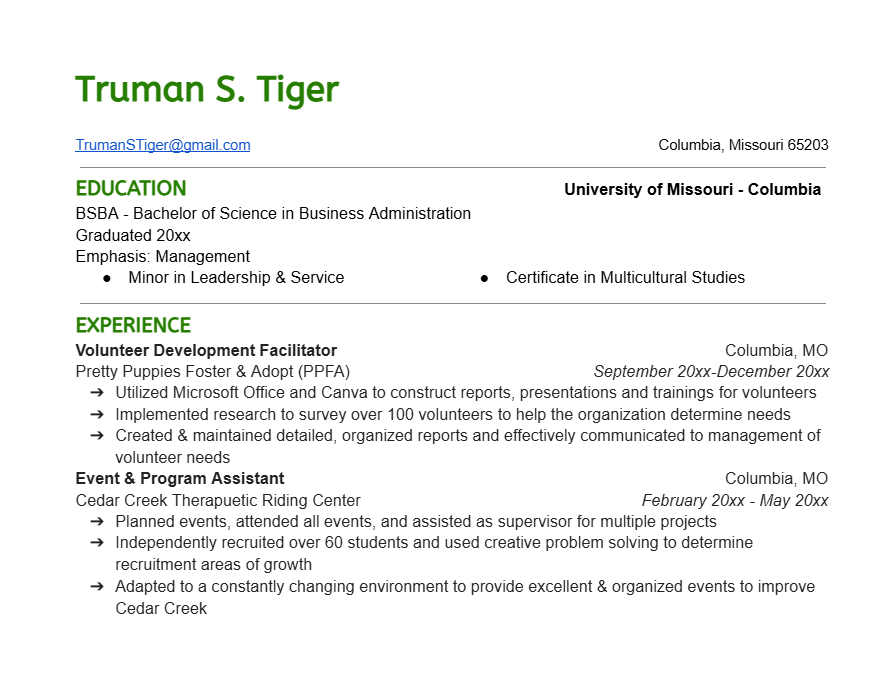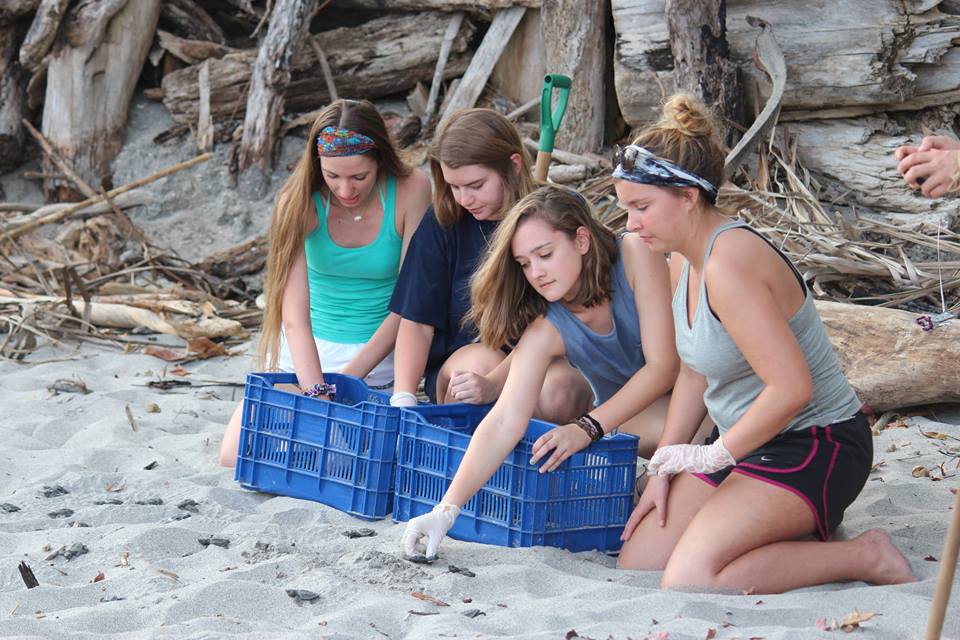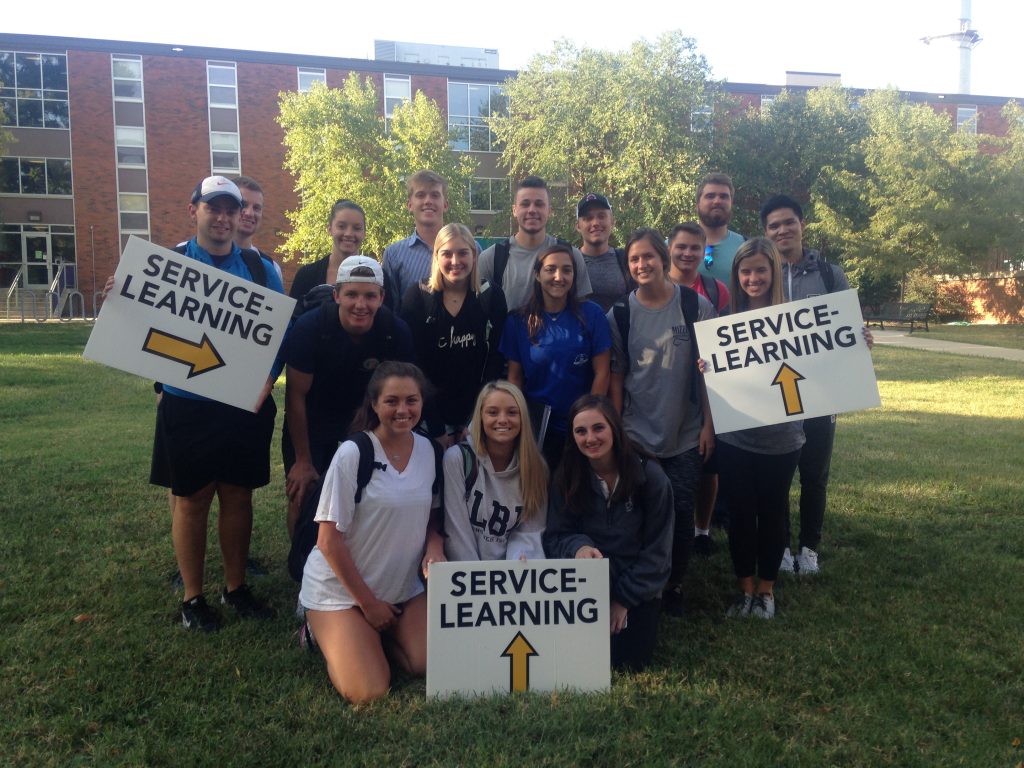Service learning or Community Engaged Learning experiences are incredible opportunities for personal and professional growth, but how do you articulate what you learned based on your experience? Every experience is different, but there are key methods you can use to add your service learning experience at MU to your resume, applications, or even job interviews.
- Adding to your Resume
- Use NACE Competencies to Articulate Skills Learned
- Talk About your Service Experience Skills In an Interview

Adding to your Resume
Adding service learning or community engaged experiences to your resume is an excellent way to showcase transferable skills, professional growth, and community impact. Here are some tips to present these experiences effectively:
1. Use a Descriptive Job Title
- Supplement vague terms like “Volunteer.” Use descriptors that describe your role, such as “Community Project Volunteer Leader,” “Environmental Educator,” or “Volunteer Health Program Assistant.” This demonstrates the depth of your involvement and responsibility. 【7】.
- Talk to your supervisor at the organization to determine an accurate and acceptable title. You can also use the GivePulse position title.
- Examples Include:
- Youth Mentor and Academic Coach – Provided one-on-one tutoring and career guidance to at-risk youth.
- Community Outreach Coordinator – Organized events to promote health awareness among minority populations.
- Environmental Conservation Advocate – Led a team in habitat restoration projects, including invasive species removal and tree planting.
- Crisis Support Liaison – Assisted with intake and provided resources for individuals in transitional housing programs.
- Program Development Assistant – Helped design and implement workshops on nutrition and healthy living for underserved families.
- Food Security Coordinator – Managed inventory and logistics for a food pantry, ensuring equitable distribution of resources.
- Education Enrichment Facilitator – Created and delivered STEM-based lesson plans for an after-school program.
- Cultural Engagement Specialist – Facilitated activities to celebrate cultural diversity at a community center.
2. Highlight Achievements with Action Verbs and Measurable Metrics
- Describe your tasks and achievements using strong action verbs like “organized,” “developed,” “led,” or “designed.” Include specific examples of your contributions, such as “Created an outreach plan that increased community event attendance by 25%”【7】【9】.
- Provide measurable outcomes when possible. For example, “Tutored 10 students, increasing their test scores by an average of 15%,” or “Managed a fundraiser that raised $5,000 for local environmental initiatives”【7】【8】.
4. Tailor Descriptions to the Job
- Use language from the job description to emphasize transferable skills. If applying for a communications role, highlight any public speaking, writing, or marketing tasks you performed during your service experience【7】【8】.
5. Summarize and Incorporate Reflection
- Mention what you learned or the skills you gained. For instance, note how the experience enhanced your leadership abilities, problem-solving skills, or adaptability【9】.
- Describe the purpose of the project or service to provide context. For instance, “Collaborated with a nonprofit to design and execute a health awareness campaign reaching 500 community members”【7】【9】.
6. Use Supporting Documentation
- If applicable, attach or refer to portfolios, badges, or certificates that validate your participation and achievements, such as a digital badge from a service-learning program【9】.
- If you completed a project-based service learning class, this is a great way to display what you accomplished!
7. Leverage Additional Sections
- If the experience isn’t directly related to your career path, include it under “Additional Experience” or “Community Service History” to show well-roundedness and commitment to social responsibility【7】【8】.
- OR create a dedicated section. Include a section titled “Relevant Experience,” “Community Engagement,” or “Service-Learning Projects” on your resume. This highlights the significance of these activities, especially if they directly align with your career goals. Place it strategically near the top if it’s highly relevant to the job you’re applying for【7】【8】
Example Resume
Contact the MU Career Center for resume examples, resume review and advice on adding these experiences

Use NACE Competencies to Articulate Skills Learned
Here are short examples of activities students might engage in while serving at nonprofits, mapped to the NACE career readiness competencies:
1. Critical Thinking and Problem Solving
- Analyzing survey data from low-income families to determine barriers to accessing after-school tutoring programs.
- Developing a new scheduling system for a food bank to streamline volunteer shifts and optimize delivery times.
- Ask Yourself -When working with children, the elderly, those with disabilities, and simply clients of a nonprofit: How did you manage when problems arose? How did you adapt to instances of conflict? How did you resolve questions you didn’t know the answer to?
2. Communication
- Writing grant proposals to secure funding for educational programs targeting underserved communities.
- Leading workshops or lessons for children on topics like nutrition, hygiene, or STEM education.
- Ask Yourself – Did you have to answer the phone, emails, or greet clients or volunteers? You likely learned a lot about professional communication skills.
3. Teamwork and Collaboration
- Collaborating with diverse volunteers to plan a community health fair serving minority populations.
- Working with a local environmental group to organize litter cleanup events.
- Ask Yourself – Did you have to work with other volunteers or your supervisor? Did you have to interact with anyone other than yourself in order to perform tasks?
4. Digital Technology
- Using graphic design software to create awareness posters for those who are houseless campaign.
- Managing social media accounts for a nonprofit, increasing engagement through targeted posts.
- Creating reports, writing emails, collecting or analyzing data. If you used AI to create any of these things, mention that.
5. Leadership
- Organizing a fundraiser for a shelter that raised $x amount for therapeutic horse riding.
- Mentoring high school students in a tutoring program, helping them develop study and life skills.
- Supervising children, clients, or a team of volunteers
6. Professionalism and Work Ethic
- Consistently arriving on time and staying late to ensure all meals are served at a soup kitchen.
- Assisting with administrative duties at a nonprofit, such as data entry or event coordination, with attention to detail.
- Maintaining good communication and positive relationships with those at your site
7. Career Management
- Attending networking events with nonprofit leaders to explore career pathways in public service.
- Documenting and presenting reflections on service experiences to align with long-term professional goals.
- Meeting important members in the community and getting their contact information
- Establishing a long-term mentorship with your supervisor, board member, or CEO
8. Global and Intercultural Fluency
- Assisting in language translation services for immigrant families accessing health resources.
- Engaging with multicultural groups to create culturally sensitive programming for children in underserved areas.

Talk About your Service Experience Skills In an Interview
1. Frame Your Experience Using the STAR Method
- Use Situation, Task, Action, and Result to structure your responses. For example:
- “During my service with [nonprofit name], I noticed a lack of accessible STEM resources for underserved students (Situation). I was tasked with designing a hands-on workshop to address this gap (Task). I collaborated with educators to develop activities and secured a $1,000 grant for supplies (Action). As a result, 50 students gained new skills in coding and robotics (Result).”
- This approach ensures your answers are clear, concise, and impactful【7】【8】【9】.
2. Link the Experience to Career Readiness Competencies
- Highlight specific skills developed through your service-learning, such as leadership, communication, or critical thinking. For instance:
- “Serving as a Community Outreach Coordinator improved my ability to connect with diverse groups and design effective communication strategies, which aligns with your focus on customer engagement.”
- Connecting skills to the NACE career competencies demonstrates how your experience translates to the professional world【9】【8】【7】.
3. Quantify Your Impact
- Employers and grad schools appreciate tangible evidence of your contributions. Include metrics like:
- “I led a team of 15 volunteers in a community health fair that provided free screenings to over 200 attendees.”
- Numbers emphasize the scale and success of your efforts【8】【7】.
4. Discuss Personal Growth and Reflection
- Share how the experience shaped your values or career goals. For example:
- “Working with children from diverse backgrounds taught me the importance of culturally responsive teaching methods, inspiring me to pursue a career in education policy.”
- This demonstrates self-awareness and a commitment to continuous learning【9】【7】.
5. Tailor Your Response to the Employer’s or School’s Values
- Research the organization or program beforehand and align your story with their mission. For example:
- “Your emphasis on environmental sustainability resonates with my experience as an Environmental Conservation Advocate, where I led habitat restoration projects to protect local ecosystems.”
- Customizing your answers shows genuine interest and alignment with their goals【7】【8】.

Sources:
Western Technical College. (n.d.). How to present relevant service experiences and community-based learning activities on a résumé. Retrieved November 15, 2024, from https://www.westerntc.edu/sites/default/files/student-life/documents/Community_Service_CBL_Resumes.pdf 【7】
University of Wisconsin-La Crosse. (n.d.). Community engagement resume ideas. Retrieved November 15, 2024, from https://www.uwlax.edu 【8】
Mesa Community College. (n.d.). Service-Learning: Community and civic engagement. Retrieved November 15, 2024, from https://www.mesacc.edu 【9】